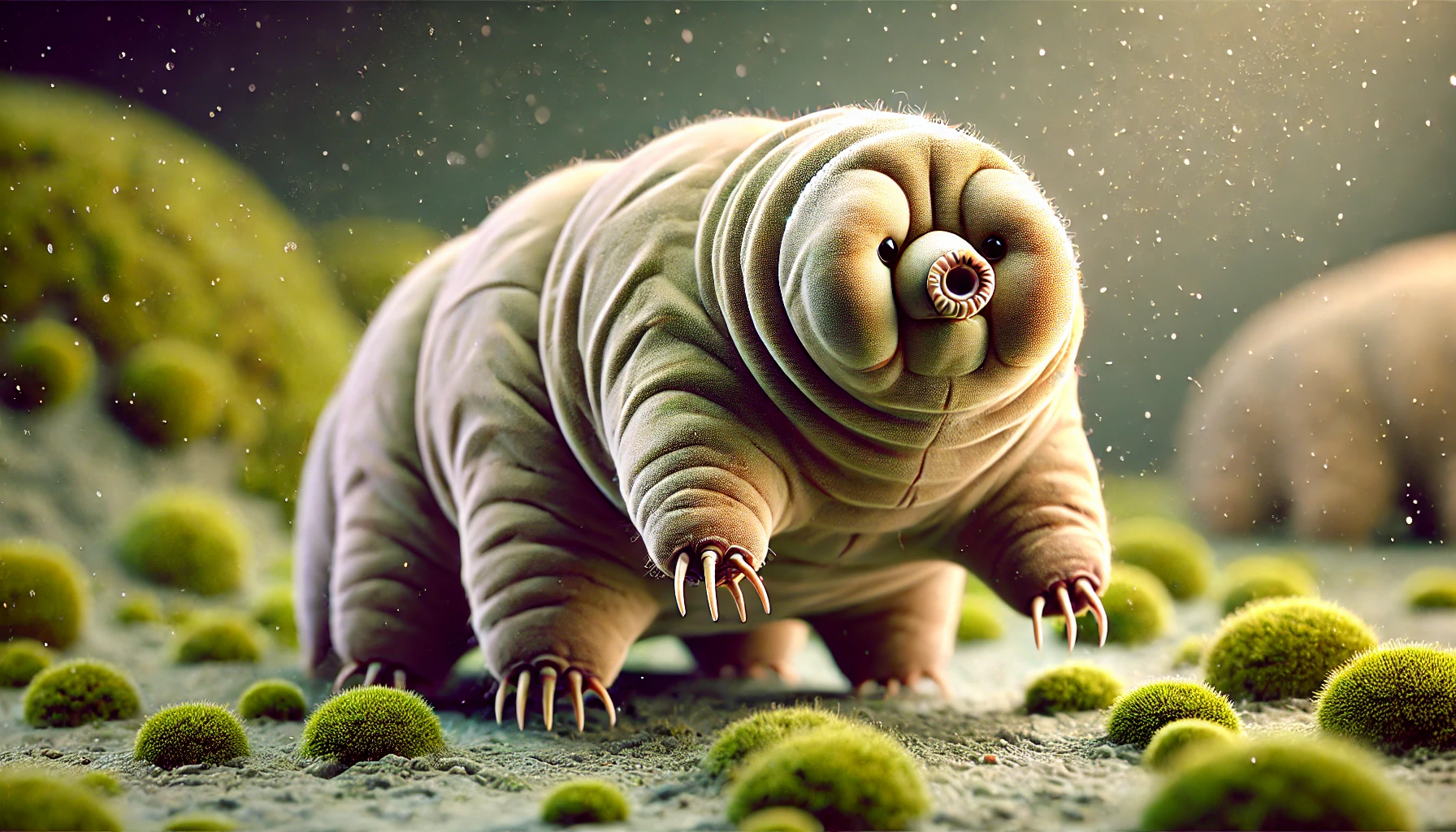Tardigrades, often called “water bears” or “moss piglets,” are some of the most resilient creatures on Earth. Despite their tiny size, they’re practically indestructible! Here are nine fascinating facts about these incredible creatures that make them truly extraordinary.
1. Extreme Temperature Tolerance
Tardigrades are champions of extreme temperatures. They can survive in conditions ranging from nearly absolute zero, -458°F (-272°C), to over 300°F (149°C).
To withstand freezing, tardigrades enter a state called cryobiosis. This process slows their metabolism and prevents ice crystals from forming inside their cells, which would otherwise destroy them.
In extreme heat, tardigrades change their cellular structure. This adaptation stabilizes proteins and membranes, protecting them from damage. Thanks to these adaptations, tardigrades can live in icy arctic tundras and boiling hot springs alike.
2. Radiation-Resistant Superpowers
Tardigrades can survive radiation levels that would be lethal to nearly any other organism. In experiments, tardigrades withstood radiation doses up to 1,000 times higher than what would kill a human.
The secret lies in a unique protein they produce called Dsup, short for “Damage Suppressor.” Dsup acts as a shield, surrounding their DNA and protecting it from the harmful effects of radiation.
Scientists are especially interested in Dsup because it could lead to breakthroughs in human radiation protection. Future applications could benefit astronauts exposed to cosmic radiation or patients undergoing radiation therapy. The tardigrade’s DNA shield could hold clues for advancing both medicine and space exploration.
3. Survival Without Water
Tardigrades can also survive without water for decades, thanks to a process called cryptobiosis. When water is scarce, they expel nearly all the moisture from their bodies and curl up into a dried, shriveled state called a “tun.”
In this tun state, they suspend all metabolic activity, essentially entering a deep, dormant sleep. Studies have shown that tardigrades in a tun state can be revived even after 30 years without water.
When they encounter water again, tardigrades simply rehydrate and resume their metabolic functions as if nothing happened. This ability to “pause” their life processes lets them survive in water-scarce environments—from dry deserts to the vacuum of space.
4. Surviving in Space
Tardigrades have accomplished something no other animal has: they’ve survived the harsh conditions of outer space. In 2007, scientists launched them outside a spacecraft, exposing them to the vacuum and intense radiation of space.
Remarkably, many tardigrades endured this extreme environment. They were the first known animals to survive space without any protective gear. This resilience has made them subjects of intense study for scientists interested in life beyond Earth.
The ability of tardigrades to withstand space conditions may one day help us understand how to protect humans or even other organisms in similar environments. They could teach us valuable lessons about surviving space travel.
5. Older Than the Dinosaurs
Tardigrades are among Earth’s oldest living creatures. Fossils indicate that they’ve been around for over 500 million years, surviving every mass extinction event, including the one that wiped out the dinosaurs.
This impressive longevity suggests that tardigrades’ extreme adaptability has played a significant role in their survival. They’ve weathered countless environmental changes that eliminated many other species.
The fact that tardigrades have survived so long helps scientists understand resilience on a broader scale. Studying their evolution could reveal how species adapt over millions of years and what traits contribute to survival.
6. They’re Found Everywhere on Earth
Tardigrades are truly global citizens. They’re found almost everywhere—from the deepest ocean floors to the frozen peaks of the Himalayas, dense rainforests, and even in your backyard.
Their incredible adaptability allows them to thrive in almost any environment. This wide distribution is one reason why they’ve survived for so long and why they’re studied in such diverse habitats.
Whether in soil, moss, sand dunes, or coral reefs, tardigrades show that life can flourish in even the most unexpected places. Their presence worldwide continues to surprise scientists and inspire curiosity about life’s resilience.
7. Unique DNA Protection
Tardigrades possess a special protein called Dsup, which stands for “Damage Suppressor.” This protein protects their DNA from harm, particularly from radiation, by forming a protective layer around it.
Dsup essentially shields their genetic material, helping to prevent mutations or damage. This feature has captured the interest of scientists who believe it could lead to new ways to protect human cells.
For example, this discovery might one day help develop treatments that shield our DNA from radiation damage, benefiting cancer patients or even space travelers. Studying Dsup may unlock new advancements in medicine and technology.
8. They’re Hermaphroditic and Can Reproduce Asexually
Tardigrades have another trick for survival: versatile reproduction. They can reproduce through sexual reproduction, which requires both male and female, but they also have the ability to reproduce asexually.
In some cases, tardigrades can produce offspring through parthenogenesis, a process where females generate offspring without needing males. This versatility is an advantage in harsh or isolated environments where mates may be scarce.
By having multiple reproduction methods, tardigrades ensure that their population can continue to grow, even under challenging conditions. This flexibility in reproduction has been key to their survival in diverse and extreme environments.
9. Potential for Future Scientific Breakthroughs
Tardigrades’ resilience isn’t just fascinating—it may also hold clues to future scientific discoveries. Scientists hope that studying tardigrades could lead to breakthroughs in fields such as medical research, biotechnology, and even space travel.
Their unique abilities to protect DNA, survive radiation, and endure extreme conditions could inspire innovations in human healthcare. For example, new treatments could be developed for preserving human cells or organs for transplants.
Whether in medicine, technology, or space exploration, tardigrades’ incredible survival mechanisms offer exciting possibilities. Studying these microscopic creatures could lead to advances that impact our lives in unexpected and beneficial ways.
These microscopic marvels continue to amaze scientists and challenge our understanding of resilience. Their survival story reminds us that life finds a way—even in the harshest environments.



Leave a Reply